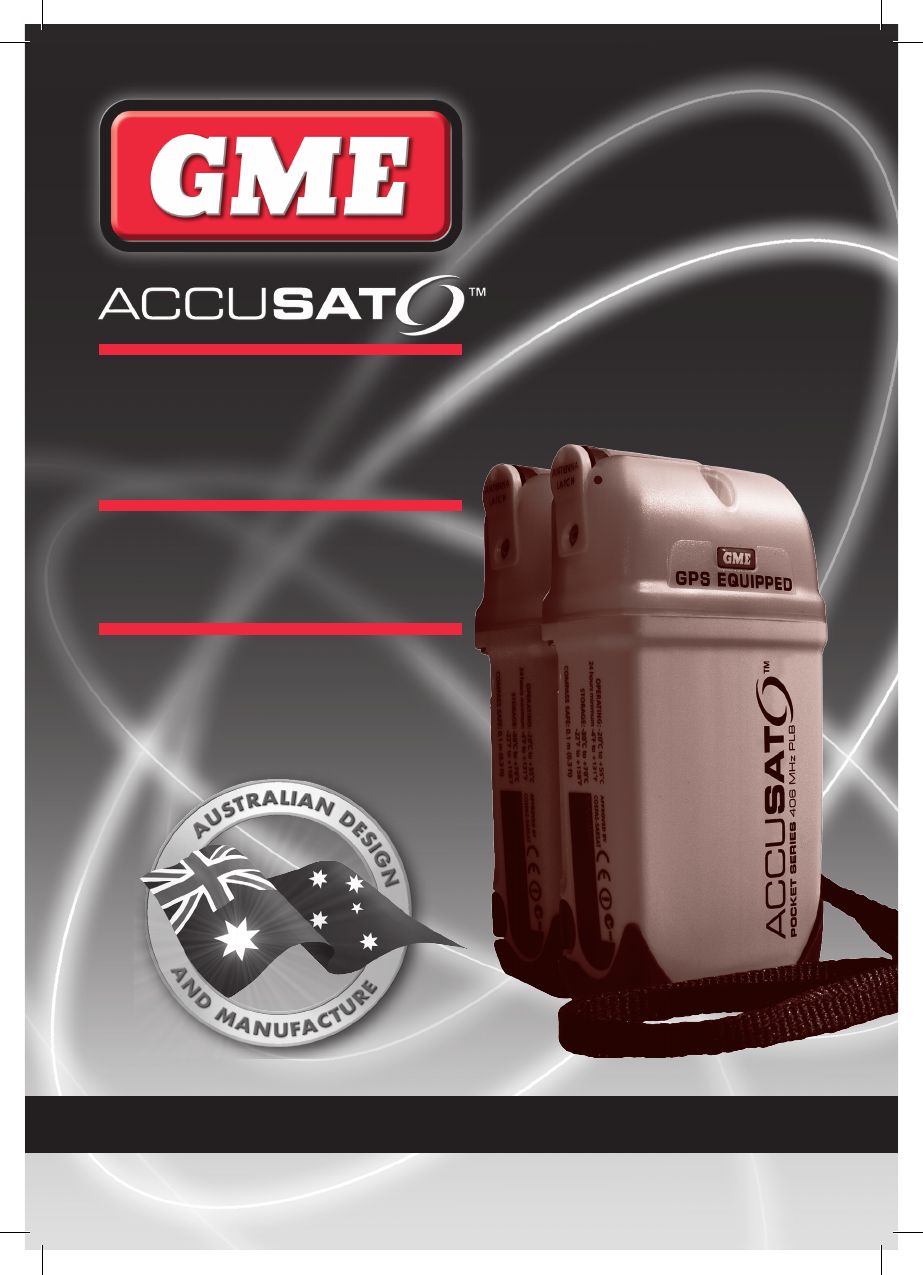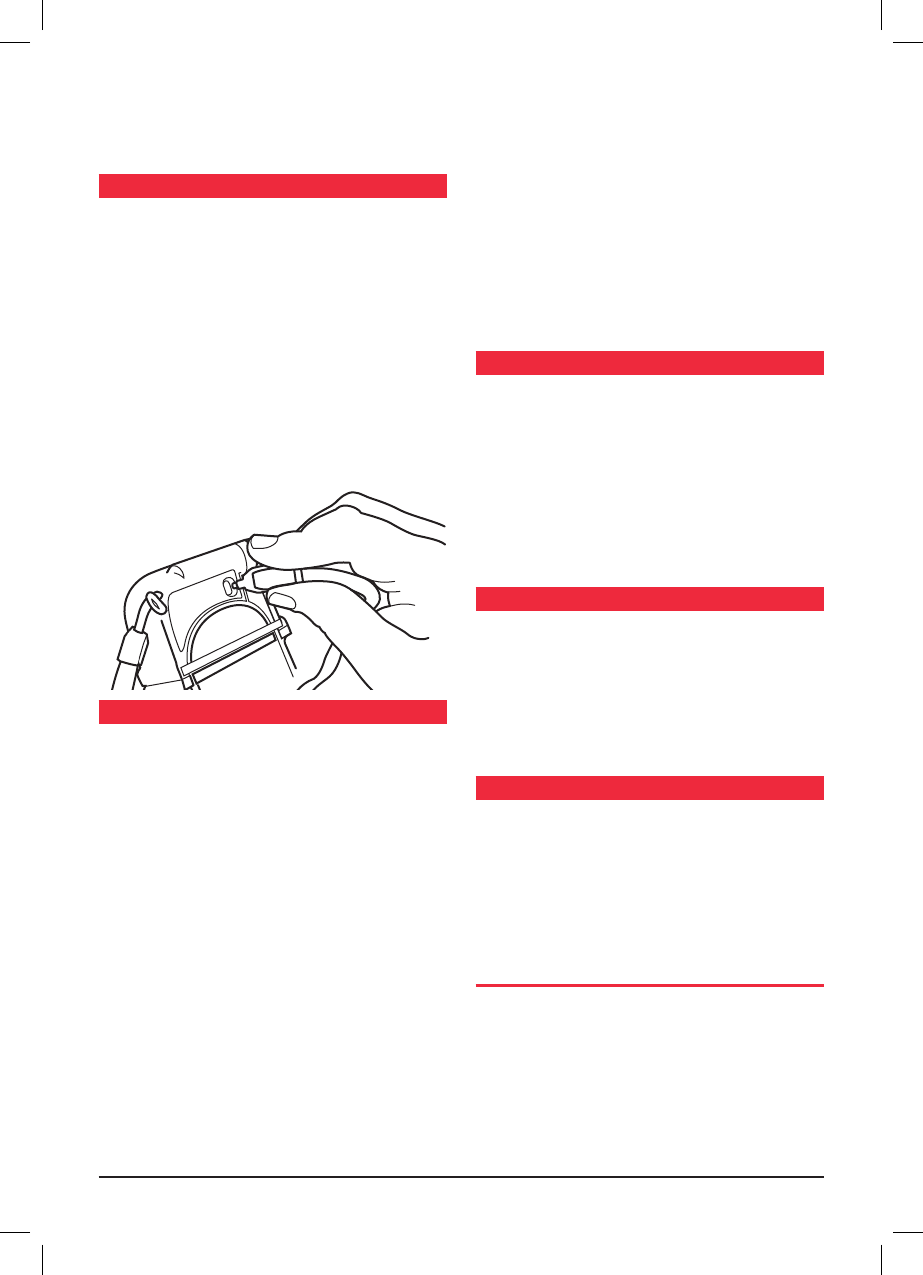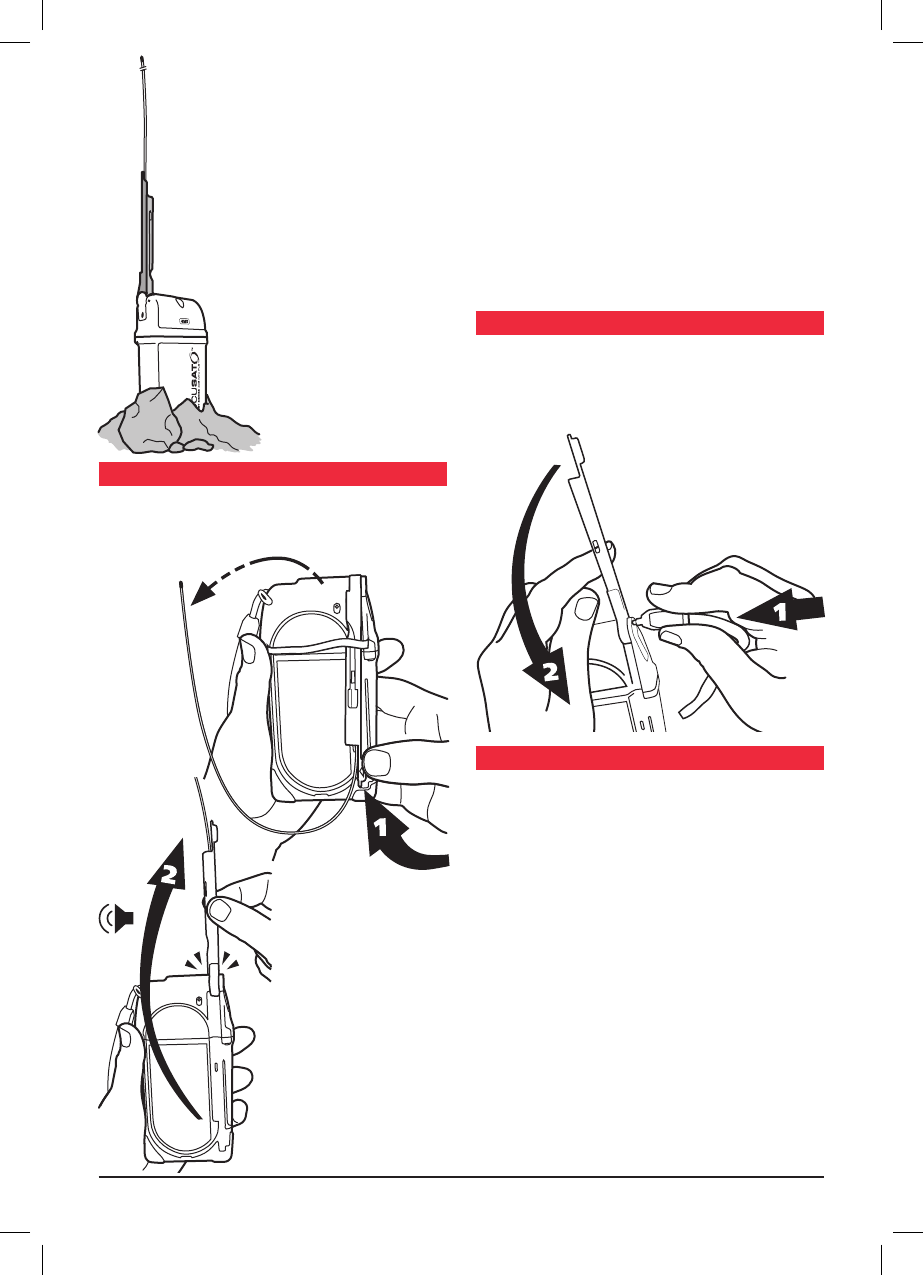Standard Communications MT410-G Class 2 Category 1 406MHz PLB User Manual MT410 and MT410G common
Standard Communications Pty Ltd Class 2 Category 1 406MHz PLB MT410 and MT410G common
MT410 and MT410G common

PAGE 1 INSTRUCTION MANUAL 406 MHZ PLB
POCKET SERIES
406 MHZ PLB
EMERGENCY
PERSONAL LOCATOR BEACON
MT410 & MT410G
INSTRUCTION MANUAL

PAGE 2 INSTRUCTION MANUAL 406 MHZ PLB
WARNING ...............................2
FEATURES ...............................2
INTRODUCTION ..........................2
General .............................2
ABOUT THE COSPAS-SARSAT SYSTEM . . . . . . . . . . 3
ABOUT 406 MHz BEACONS .................3
REGISTRATION & TRANSFER OF OWNERSHIP . . . . 3
Registration Contacts . . . . . . . . . . . . . . . . . . . 3
PREVENTING ACCIDENTAL ACTIVATION . . . . . . . . 4
Contacts for Reporting Activations . . . . . . . . . 4
BATTERIES & MAINTENANCE . . . . . . . . . . . . . . . . 4
TESTING THE PLB .........................5
GPS SATELLITE ACQUISITION TEST . . . . . . . . . . . . . 5
SAFETY SEAL ............................5
TRANSPORTATION ........................5
ACTIVATION IN AN EMERGENCY . . . . . . . . . . . . . . 5
Location for deployment . . . . . . . . . . . . . . . . . 5
ACTIVATING THE MT410/410G . . . . . . . . . . . . . . . 6
DEACTIVATING THE MT410/410G . . . . . . . . . . . . . 6
DISPOSAL ...............................6
SPECIFICATIONS ..........................7
WARRANTY ...................... back page
NATIONAL AUTHORITY INFORMATION . . back page
CONTENTS
FEATURES
• Suitable for marine, aviation and land
applications.
• GPS model available - Accusat Pocket Pro+
(MT410G).
• 7 year Battery life, 7 year Warranty.
• Typical accuracy - MT410G: <45 m MT410: <5 km.
• High visibility strobe light.
• Unique patented technology - no warm up period.
• Featherweight, compact and robust construction.
• Digital 406 MHz, 5 Watt transmission plus 121.5 MHz
homing signal.
• COSPAS-SARSAT worldwide operation.
• National and International Approvals.
• Buoyant and waterproof design (exceeds IP67).
• Simple 2-step activation.
• Complete with retention strap and protective
carry pouch.
INTRODUCTION
Congratulations on purchasing your new Accusat Pocket
Series Personal Locator Beacon (PLB). The GME Accusat
Pocket MT410 and GPS equipped Accusat Pocket Pro+
MT410G are the most advanced 406 MHz digital satellite
beacons available today. Using new digital frequency
generation technology, GME have developed and approved
world wide, a new family of affordable high performance
406 MHz Personal Locator Beacons
GENERAL
The GME MT410 and MT410G PLBs are designed for use
when the safety of life is endangered and you have no
other means of communication. The PLB can save your life
and the lives of others by leading an air, land or sea rescue
to your precise location.
PLBs are an excellent choice to provide added safety while
participating in just about any outdoor or remote area
activity. The MT410/410G beacons are fully sealed units
and will not sink if dropped into water, making them
equally suitable for use on board a boat, or in many other
diverse water sport adventures.
Note: PLBs are not a satisfactory substitute for situations
which require the specifically designed GME Marine EPIRBs. An
EPIRB is designed to float unassisted with the antenna above
the water surface to meet Maritime Authority requirements.
WARNING
EMERGENCY BEACONS SHOULD ONLY BE USED IN SITUATIONS
OF GRAVE AND IMMINENT DANGER.
It is important that you read this manual thoroughly.
Compliance Statement and Application
Certificates: please visit: www.gme.net.au/epirb

PAGE 3 INSTRUCTION MANUAL 406 MHZ PLB
In the past, using the analogue system, (which will become
obsolete in February 2009) extensive and lengthy searches
have been carried out for missing persons, sometimes to
no avail. Your GME PLB is a self contained 406 MHz digital
radio transmitter that emits an internationally-recognized
distress signal on a frequency monitored by the COSPAS-
SARSAT satellite system. The MT410 and MT410G contain
a unique identity code which can be cross referenced to
a database of registered 406 MHz beacons, allowing the
beacon’s owner to be immediately identified in the event of
an emergency. Both PLB models include a high performance
solid state strobe and 121.5 MHz VHF homing signal to
assist in leading rescuers to your precise location.
The MT410G also features an integrated 16 Channel GPS
Receiver which when activated, will automatically acquire a
position and relay the latitude and longitude of the beacon
along with the personal identifier and emergency signal.
ABOUT THE COSPAS-SARSAT SYSTEM
The COSPAS-SARSAT system is a complete global search
and rescue service using geostationary and polar orbiting
satellites. Many countries provide ground facilities known
as Local User Terminals (LUTs).Polar orbiting satellites
provide complete, although non-continuous, coverage
of the earth (due to fact that these satellites can only
view a portion of the earth at any given time) and can
accurately resolve an active beacons’ location. Additionally,
geostationary satellites can give an immediate alerting
function in many regions of the world.
The basic COSPAS-SARSAT concept is illustrated in the
following diagram
ABOUT 406 MHZ BEACONS
406 MHz beacons provide more accurate and reliable
alert data to search and rescue agencies than the older
121.5/243 MHz systems presently being phased out.
The older 121.5 MHz analogue system required that the
satellite be within view of both the beacon and the LUT
before it could transmit the beacons’ position. This limited
the coverage to an area immediately surrounding the LUT.
However, the digital nature of the 406 MHz system means
that the satellites are able to store the beacons’ position and
digital message, no matter where in the world it is received.
These details are then relayed to the next LUT that comes
into range, giving the 406 MHz system true global coverage.
REGISTRATION & TRANSFER OF OWNERSHIP
Registration of your 406 MHz satellite PLB
with the Registration Section of your National
Authority is important and now mandatory in
most countries because of the global alerting
nature of the COSPAS-SARSAT system.
Owner Registration Forms for registering your beacon may
be supplied within the packaging, otherwise, your National
Authority will be able to provide the correct forms. Up to
date forms are often available online.
The information provided in the registration is used only
for search and rescue purposes. Promptly fill in the owner
registration form upon completion of the sales transaction,
then mail, fax or email it to your National Authority. If the
PLB is to enter service immediately, complete the
registration form and fax or email the information.
Should the PLB be transferred to a new owner, as the
previous owner you are obligated to inform your National
Authority by email, fax, letter or telephone of the name and
address of the new owner. The new owner of the beacon
is also required to provide their National Authority with
the information as shown on the registration form. This
obligation transfers to all subsequent owners.
Note: Your MT410/MT410G has been programmed with
a unique identifying code which will be transmitted by the
beacon in an emergency. Registering your beacon provides
the authorities with immediate access to your details when
the beacon is detected. This means they will know who you
are and who your emergency contacts are. In situations of
accidental activation they can also immediately eliminate
your beacon as an emergency situation by contacting you
when activation is detected.
REGISTRATION CONTACTS
Australian users - Address all correspondence to:
Beacon Registration Section, AusSAR
Australian Maritime Safety Authority
GPO Box 2181, Canberra City, ACT 2601.
Phone: 1800 406 406 or International: +61 2 6279 5041.
Fax: 1800 622 153 or International: +61 2 6230 6868.
Email: ausbeacon@amsa.gov.au.
New Zealand users - Address all correspondence to:
Rescue Co-ordination Centre New Zealand
PO Box 30050, Lower Hutt 6009.

PAGE 4 INSTRUCTION MANUAL 406 MHZ PLB
Phone: +64 4 914 8383. Fax: +64 4 914 8388
Email: 406registry@maritimenz.govt.nz
Ensure information is current. Notify the appropriate
authority if ownership of the beacon is transferred.
Other areas - Please contact your Country Distributor
as shown on page 8 of this manual. If you have a beacon
coded with a foreign country code, or if you do not know
what country code has been used, then you will need
advice, please contact the relevant authority on one of the
numbers shown above or visit:
www.cospas-sarsat.org/BeaconsCodingGuideGeneral/poc.htm
PREVENTING ACCIDENTAL ACTIVATION
The signal from a PLB is regarded by authorities as an
indication of distress and is given an appropriate response.
It is the responsibility of every owner of a PLB to ensure
that it is not activated unintentionally or in situations that
do not justify its use.
Most cases of accidental transmission result from poor or
inappropriate storage or failure to totally disable an old
model beacon before disposal.
The need to treat emergency beacons responsibly cannot be
too highly emphasised.
The MT410/410G will not commence transmitting until
approximately 60 seconds after activation, providing a
period of audible and visual warning. If you hear the
beacon beeping while it is being carried or stowed, you may
still be able to deactivate it during this time period without
actually transmitting a distress signal. If in doubt, report the
incident to your local authorities just in case.
To minimise the possibility of accidental activation, PLB
owners are urged to pay careful attention to the
following points:
1. Follow the self-testing procedures
2. Educate your travelling companions on how and when to
correctly operate your PLB
3. Avoid stowing the PLB where it will be subjected to
continuous direct sunlight. This could cause the beacon’s
internal temperature to exceed the maximum storage
temperature of +70°C. Long term stowage under
these conditions could result in reduced battery life,
poor performance or degradation of the plastics due to
excessive U.V. light.
4. Do not allow children to interfere with the PLB.
CONTACTS FOR REPORTING ACTIVATIONS
If you suspect that a PLB has been activated inadvertently,
you MUST turn it off and report it immediately to your
National Authority‘s Rescue Co-ordination Centre to
prevent an unnecessary search.
When reporting you should include the following:
1. Your PLB’s 15 character Unique Identifier Number (UIN),
which is marked on the unit body.
2. Date, time and duration of activation.
3. Cause of activation.
4. Location at time of activation.
Search and Rescue authorities will not penalize an EPIRB
owner or operator in cases of genuine accidental activation.
Contact numbers:
Australia: 1800 641 792
New Zealand: 0508 472 269
United States of America: (800) 323 7233
United Kingdom: 01326 317 575
BATTERIES & MAINTENANCE
The MT410 and MT410G PLBs are fitted with the very
latest in high capacity battery technology. These batteries
are able to operate within a temperature range of -20°C
to +55°C.
The full operational capability of your beacon may not
be available if the batteries fitted have exceeded their
replacement date, as shown on the body of the unit.
Prior to reaching this date, make arrangements to have
your MT410/MT410G returned for service.
Note: PLB maintenance operations, including battery
replacement, require that the beacon be returned to a
manufacturer approved service facility. A list of authorised
Service Centres can be found on: www.gme.net.au.
The replacement of batteries due to expiry or usage is not
covered by the product‘s Warranty.
MT410/MT410G batteries are not user replaceable.
Although the MT410/410G are otherwise maintenance
free, routinely following these few simple steps will help
ensure that your beacon will be operationally ready if
called upon:
1. Test the PLB at the recommended interval.
2. Confirm the SAFETY SEAL has not been broken.
3. Check that the batteries have not passed their
replacement date.
4. Inspect the MT410/410G for physical damage
or deterioration.
5. Keep the unit clean by wiping over with a damp cloth
(warm water and mild detergent are suitable), then dry.

PAGE 5 INSTRUCTION MANUAL 406 MHZ PLB
If there is any doubt as to the products’ serviceability,
immediately contact your authorised Dealer or Service
Centre for advice.
TESTING THE PLB
It is recommended that you test the MT410/410G at regular
intervals to ensure it is fully functional. You should also test
the beacon prior to an extended journey.
WARNING •
DO NOT over test
– testing consumes some
battery power, no more than once per month.
•
DO NOT deploy the antenna as this will
break
the seal and activate the beacon to
transmit
a distress signal after 60 seconds.
You may test the PLB using the following procedure:
1. Remove the beacon from the carry pouch.
2. Use the key (attached to the lanyard) to slide self test
switch down and then release, a ‘double beep’ and a
strobe flash will indicate the MT410/
MT410G is functioning
correctly.
GPS SATELLITE ACQUISITION TEST
The standard self test procedure is more than sufficient to
perform a comprehensive check of your beacon without
consuming too much battery capacity. On occasions, and
no more regularly than on average once a year, you may
wish to perform a GPS satellite acquisition check
(MT410G only).
Whereas the routine self test verifies the GPS receiver’s
circuitry, the full test will include the operation of the
special GPS antenna as well.
1. This test consumes much more power than a standard
self test so choose a test location with good visibility of
the open sky above. A quick satellite acquisition means
a short test, and less wasted power consumption.
2. Carry out a self test in the usual way but rather than
releasing the key, continue to hold it in position. After
the self test pass confirmation, both the strobe flash and
the internal beeper will start. Count four flashes/beeps
then immediately release the key.
3. The MT410G will continue to flash and beep whilst it
searches for available satellites. This may continue for
a number of minutes depending on the number and
location of satellites present. It is not possible to abort
the test once started, and note that distress signals are
not radiated as part of this test.
4. If no satellites are found after a predetermined time the
repetitive flash and beep will stop. This may indicate a
fault with the GPS receiver system within the PLB and
you should contact your local service centre for advice.
If the test terminates with a rapid sequence of flashes and
beeps then GPS satellite acquisition and correct operation
has been confirmed.
SAFETY SEAL
The safety seal which covers the antenna on the rear side
of the beacon is designed to tear if the unit is switched on.
A safety seal that is not broken serves to indicate that the
beacon has never been manually activated.
NEVER remove or break the seal unless deploying the PLB
in an emergency.If the beacon has been activated for any
length of time, the batteries can no longer be guaranteed
to have the capacity to operate for the minimum 24 hour
period and therefore must be replaced.
TRANSPORTATION
GME PLBs use batteries with a low level of lithium content.
Consequently GME PLBs are classed as ‘non-hazardous
products’ by IATA and maybe shipped without DG
declaration
and carried without problem (accompanied
or unaccompanied) on passenger aircraft. However, it is
advisable that you check with your carrier that they do not
have specific restrictions which may apply to you.
ACTIVATION IN AN EMERGENCY
PLBs should only be activated in situations of grave and
imminent danger. Deliberate misuse may well result in the
unnecessary deployment of valuable Search and Rescue
resources and could incur a severe penalty.
Should there be an inadvertent activation it is the
responsibility of the user to immediately switch the beacon
off and notify the nearest RCC (Rescue Coordination Centre).
LOCATION FOR DEPLOYMENT
The MT410/410G will deliver best performance where there
is a clear view of the sky. Deploying the beacon within an
enclosure, particularly one which is electrically conductive
such as under a car roof, will reduce the signal strength and
may mean that it cannot be detected by rescue satellites or
overflying aircraft. If you find yourself in a narrow valley or
ravine, you can greatly increase the chances of your beacon
signal being detected by placing it on higher ground.

PAGE 6 INSTRUCTION MANUAL 406 MHZ PLB
Deploy the beacon in an upright position with
the wire antenna vertical and well clear of
any surrounding obstructions such as trees
or rocks. If adverse weather conditions exist,
use any available props around the base of
the beacon to ensure it will not topple over.
Where on-person operation is unavoidable,
choose an elevated position that also achieves
good local clearance around the vertical
wire antenna.
Once the beacon has been
activated, leave it switched on.
A continuous signal is needed for
Rescue Authorities to determine
your location.
ACTIVATING THE MT410/410G
1. Hold firmly and release the antenna by pushing the black
arm (where marked by a yellow triangle) inwards then
upwards The antenna will quickly uncoil and extend.
2. Swing the antenna fully
upwards 180 degrees
clockwise, breaking the
safety seal. The antenna
arm will click into place.
The PLB is now ACTIVE.
The MT410 will ‘beep’ and pulse the inbuilt strobe 20-21
times per minute.
The MT410G will emit a rapid series of ‘beeps’ and strobe
flashes for a period of 6 seconds, indicating to the user
that it has acquired a GPS position fix and is relaying this
position along with the distress signal and the unique
personal identifier to the COSPAS-SARSAT satellite system.
After 6 seconds the MT410G will continue to ‘beep’ and
pulse the strobe 20-21 times per minute.
DE-ACTIVATING THE MT410/410G
1. Using the key (attached to the lanyard) depress the
antenna latch.
2. Swing the antenna fully down 180 degrees anti-
clockwise and latch.
3. Re-wrap antenna around the
groove on unit back.
The PLB is now turned OFF and the
audio and visual alerts will cease.
DISPOSAL
Special precautions must be taken when finally disposing
of your beacon at the end of it’s useful life. Legislation may
determine the specific requirements which apply to you.
In the first instance, contact your National Authority for
advice. The following information may also be helpful:
To permanently disable the beacon:
1. At the rear of the beacon remove the two retaining
screws located just under the safety seal. Turn the unit
over and remove a third screw from the middle of the cap.
2. Release the antenna just sufficiently to allow the cap to
be partially withdrawn, remove the yellow plastic insert
from the front centre to allow the unit to slide apart.
3. Unplug the battery leads at the base of the circuit board.
•
Lithium batteries are generally not considered as hazardous
waste when fully discharged. Qualified personnel may be
able to slowly and safely discharge the cells for you.
• The MT410 and MT410G contain many recyclable parts.

PAGE 7 INSTRUCTION MANUAL 406 MHZ PLB
MODES OF OPERATION
Activated: UHF (406) and VHF (homer)
complete with high intensity strobe
and audible alert.
Self Test: Comprehensive internal diagnostics
with visual and audible operator
feed-back. UHF test message
(inverted synchronisation compatible
with portable beacon testers).
GPS satellite acquisition test
(MT410G only).
OPERATION
Activation: Automatically when antenna
deployed.
Duration: In excess of 24 hours at -20°C
Longer at higher ambient
temperatures.
Transmission: 121.5 MHz and 406 MHz
Delay: 60 seconds to de-activate prior
to distress transmission.
Warm Up: None required (due to patented
digital frequency generation).
VHF: 121.5 MHz, 50 mW ±3 dB, swept
tone AM (analogue).
UHF: 406.028 MHz, 5 W ± 2 dB,
PSK (digital).
Strobe: > 20 flashes/minute
2 x high intensity white LED.
COSPAS-SARSAT: Certified to C/S T.001 (Class 2)
requirements.
Approvals: AS/NZS 4280.2, ETSI EN 302 152-1
UHF-Protocol/Data:
Supports all short (MT410) and
long (MT410G) operation protocols
(re-programmable by Distributor).
Repetition Period: 50 s mean, digitally generated
randomization.
VHF: Satellite compatible phase coherent
BATTERY
Replacement
Period: Prior to expiry date marked on
case - (7 yrs), or after use.
Replacement
Method:
Service centre or factory only
(non-user replaceable).
Battery Chemistry:
LiMnO2 (0.49 g Lithium per cell)
Battery
Configuration:
2 electronically isolated batteries,
each consisting of 2 cell types
CR17345.
PHYSICAL
Operating:
-20 to +55°C
Storage:
-30 to +70°C
Weight:
MT410 - 235 g, MT410G - 250 g
Compass Safe
Distance:
0.1 m (for minimal deflection)
Dimensions (mm):
135 (h) x 71 (w) x 38 (d)
Buoyant:
Will float in fresh/salt water
(RTCM Cat2).
Waterproof:
Submersion to 1 m, exceeds IP67.
Materials:
High visibility yellow chassis with
translucent cap. UV stabilised high
impact plastic chassis with energy
absorption over-moulded bumpers.
GPS RECEIVER (FITTED TO MT410G ONLY)
Type:
Ultra-high sensitivity L1
frequency C/A.
Channels:
16 Channel, 8192 time/frequency
search windows.
Antenna:
Dielectrically loaded quadrifilar helix
Acquisition:
Cold start 34 seconds typical
Hot start <3.5 seconds typical.
Position:
Located to within 45 m typical
OTHER FEATURES
Transport:
Meets UN requirements for
transport as non-hazardous cargo
on board passenger aircraft.
Antenna:
Flexible, self straightening and
robust wire rope design. Marine
grade 316 Stainless Steel.
Included
Accessories:
Wrist/Neck strap.
Protective carry pouch with
multidirectional belt loops.
SPECIFICATIONS*
*All specifications are typical and subject to change without notice or obligation.

GME limit this warranty to the original Purchaser of the
equipment.GME warrant this product to be free from
defects in material and workmanship for a period of 7 years
from the date of purchase from the authorised Dealer.
Replacement of batteries due to expiry or usage is excluded
from this Warranty.Should the product require servicing
during this period, all labour and parts used to effect
repairs will be supplied free of charge. GME reserve the
right to determine whether damage has been occasioned
by accident, misuse or improper installation, whereby the
Warranty could be void.In the event of a defect occurring
during the Warranty period, the original Purchaser may
return the defective unit along with suitable proof of
purchase (i.e. receipt, credit card slip etc.) and a full
description of the defect to the Dealer from whom the unit
was purchased.
The Dealer will forward the unit to an authorised GME
Service Depot in your State.
All freight charges incurred for transportation by the Dealer
or GME are the Purchasers’ responsibility.
International customers should contact their in-country
distributor or contact GME directly at: info@gme.net.au
Owner Details
: Name: ..........................................................................
Address: ........................................................................
...............................................................................
Tel: ............................................................................
ID Code #: ......................................................................
Distributed by:
Australia 24 Hour Emergency Contact
Phone: 1800 641 792 or
International: +612 6230 6811
New Zealand: 24 Hour Emergency Contact
Phone: 0508 472 269 or
International: +64 4914 8389
WARRANTY
NATIONAL AUTHORITY INFORMATION
A Division of:
Head Office: SYDNEY- Locked Bag 2086, North Ryde N.S.W. 1670, Australia. Tel: (02) 9844 6666, Fax: (02) 9844 6600.
MELBOURNE ADELAIDE PERTH BRISBANE SYDNEY AUCKLAND
7 Mircro Circuit 14 Phillips St. Unit 1 Unit 1 Unit B Unit F
Dandenong South Thebarton 10-12 Harvard Way 89-101 Factory Rd. 22-24 College St. 35 Neilpark Dr.
Vic. 3165 S.A. 5031 Canning Vale Oxley Gladesville East Tamaki
Tel: (03) 9798 0988 Tel: (08) 8234 2633 W.A. 6155 Qld. 4075 N.S.W. 2111 N.Z.
Fax: (03) 9798 0177 Fax: (08) 8234 5138 Tel: (08) 9455 5744 Tel: (07) 3278 6444 Tel: (02) 9879 8888 Tel: (09) 274 0955
Fax: (08) 9455 3110 Fax: (07) 3278 6555 Fax: (02) 9816 4722 Fax: (09) 274 0959
For customers outside Australia and New Zealand, please contact your local GME Distributor or email to: export@gme.net.au
Part Number: 310361 Drawing Number: 43 0 03 - 1